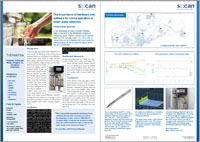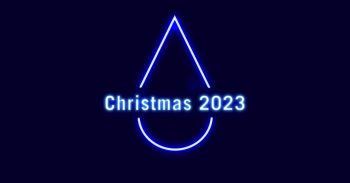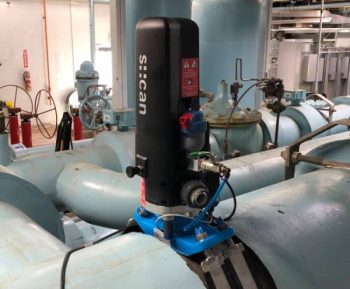s::can technology is used to monitor drinking water in real-time in the distribution network of Tarragona, Spain. Stations monitor up to 9 parameters (UV254, turbidity, color, TOC, DOC, free Cl, conductivity, pH & Temperature) together with event detection software based on UV-Vis spectral alarms which are sent to EMATSA.
The city of Tarragona upgraded to a smart drinking water network

Background
Background
A few years ago large water utilities started to consider benefits for operating smart drinking water networks. Real-time monitoring of the distribution network allows water utilities to make sure that water quality is kept from the source all the way to the tap. In addition, it helps to make sure the water which is purchased from other companies complies with the expected quality. It also can identify water sources in case there is more than one, identify different origins (surface water, ground water, brackish water), know the percentage of water from each source and even make sure any intentional or unintentional contamination is detected. In Spain s::can’s online monitoring micro::stations are installed at the water tanks of EMATSA. EMATSA manages the entire water cycle in the city of Tarragona with a population of around 150.000 people. Water supplied is both surface and ground water (80:20).
The image above shows a 3D spectral fingerprint in moni::tool. The clearly visible peak was caused spiking the online pipe system in a closed loop with nitrates.
Installation
micro::stations were equipped with free chlorine, conductivity and pH sensors together with a UV-Vis spectrometer. The UV-Vis sensor has 35mm optical window length and is cleaned with a rotating brush. All sensors are connected to a con::cube terminal, a high-performance, power efficient industrial computer, with very flexible options for interfacing to SCADA or any central database. Stations were provided with an IP address and 3G network in order to allow users to connect in remotely.
Results and discussion
For some parameters such as UV254, TOC, DOC, pH and turbidity, online values were stable. For others, like free chlorine, nitrates, conductivity and temperature, some fluctuations were monitored. Nitrate peaks were monitored when the water source was switched from surface water to ground water from wells.
Conclusions
micro::stations show very good correlation to laboratory values. They are able to detect sudden changes due to changes in operation, especially for nitrates when the water source was modified. When intentional contaminations from manual dosing were applied in a closed loop, the event detection software ana::tool successfully detected pattern alarms and spectral alarms. The monitoring station, micro::station, integrates a third party online equipment through modbus TCP for microbial monitoring and to run in-house s::can software on it.
Related Posts
-
Christmas at s::can
 December 2023 I As always, we like to use the Christmas season to express our appreciation for the successful and…
December 2023 I As always, we like to use the Christmas season to express our appreciation for the successful and… -
Achieving operational excellence –
How the pipe::scan transformed water quality monitoring Union Water Supply System (UWSS), an Ontario Clean Water Agency managed facility, is responsible for servicing 66,800 residents in the…
Union Water Supply System (UWSS), an Ontario Clean Water Agency managed facility, is responsible for servicing 66,800 residents in the… -
Pre-Boarding
 July 2023 I Today we give you an insight into what happens behind the scenes until your first day at…
July 2023 I Today we give you an insight into what happens behind the scenes until your first day at…




